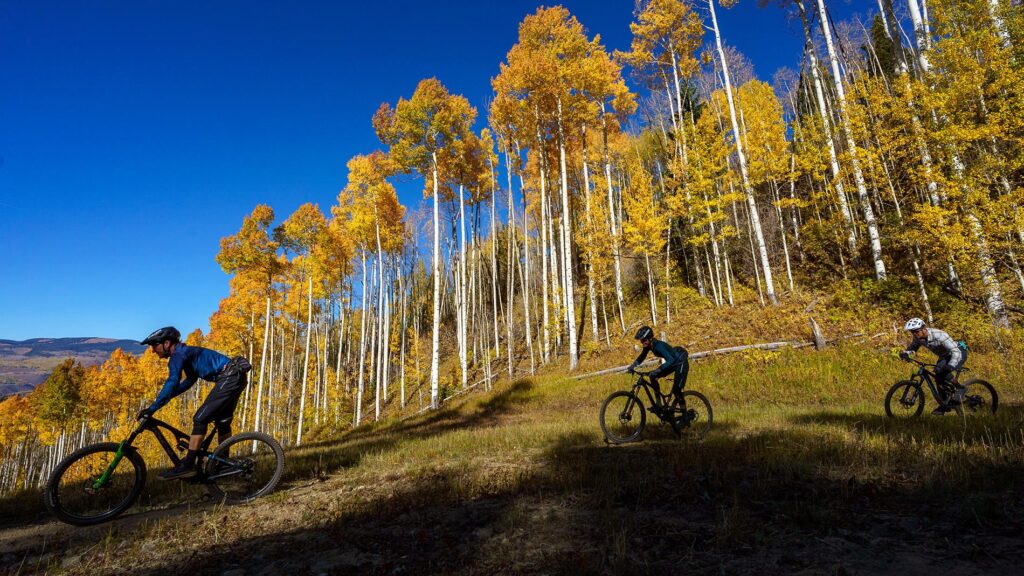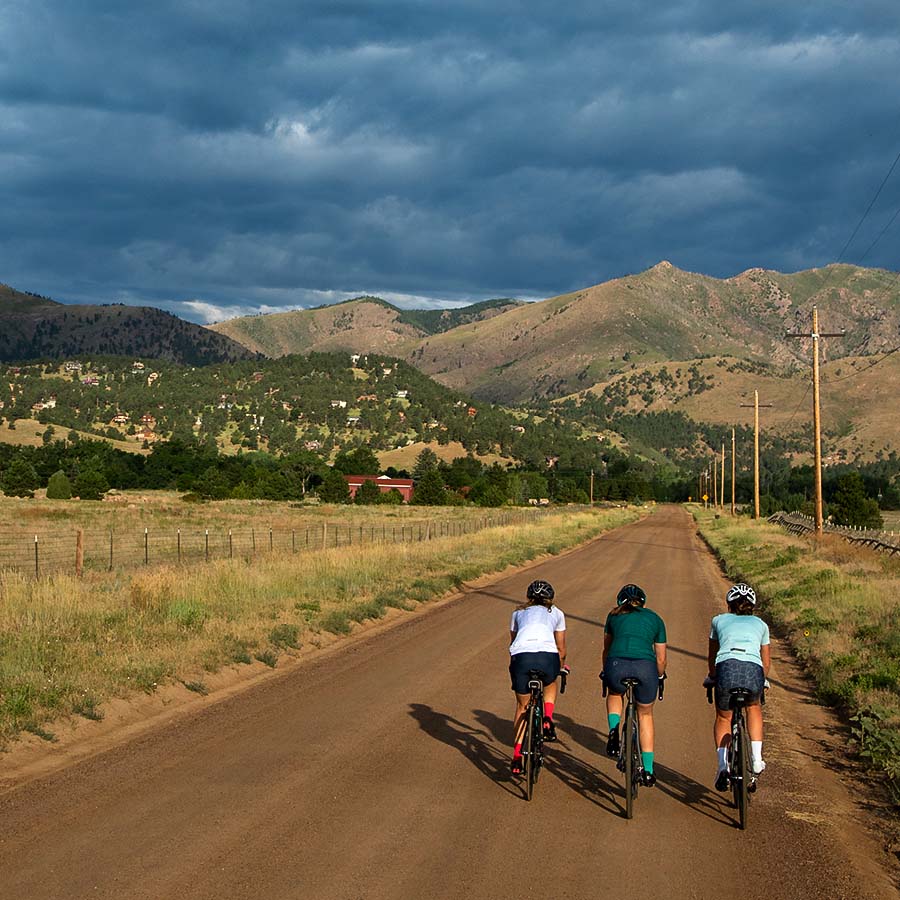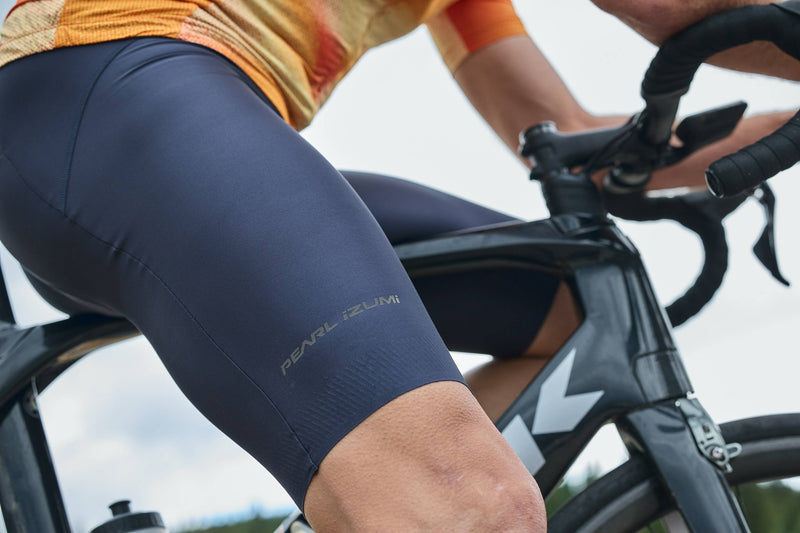If you’re just getting into cycling this post is for you. Our apparel guide is here to provide a few tips on gear and clothing choices, so you can get rolling faster. We’ll cover the necessities (and a few luxuries) for both mountain biking and road/gravel riding.
Mountain Biking
Shoes
Shoe choice is an important decision in mountain biking. This discipline of cycling is dynamic, requiring a flexible yet secure connection to the bike. It requires standing on the pedals often, learning to properly shift your weight to roll over different features, driving the bike with your feet while coasting, and possibly hiking steep or rugged sections of trail. The mountain biking skillset requires a shoe that is both nimble and secure, while providing good traction and protection in the upper. No matter which option you chose from our line, we’ve got you covered.
Flats or clipless? If you’re totally new to cycling, it’s probably best to start with flat pedal shoes. These are designed to work with a flat (or “platform”) pedal that has small metal pins protruding from its level surface. The pins interact with a mountain bike-specific sticky rubber on the bottom of the shoe, creating more friction between shoe and pedal so you feel more connected. This design still allows the rider to easily step off when things get too rowdy. With this setup, you can focus on the trail ahead without the distraction or nerves that often accompany getting used to clipless pedals. You can use this system for the rest of your MTB life or switch to clipless later on.
For the uninitiated, clipless shoes have a cleat on the bottom that locks into its corresponding pedal, much like a ski binding. The cleat that you’ll install on the bottom of the shoe comes with the pedals you purchase, which means you can buy shoes before deciding on a clipless system. A twisting movement of the foot from the heel releases you from the spring-tensioned pedal, and it can take a bit of practice to do this quickly and reliably on challenging terrain. Get some practice in (near some soft grass) before you go send it on the trail. (And, if you’re wondering why you “clip in” to clipless pedals, here’s a quick read that explains this counterintuitive terminology.)
Riders with experience riding roads in clipless pedals may opt to try mountain biking in them from the outset. Switch to a set of shoes designed for mountain biking, though, as they come with grippy tread on the bottom for walking and a protective upper ready to handle some dirt and abrasion. The most significant difference between MTB and road pedals are in the cleat; MTB pedals and cleats allow “entry” on both sides for faster engagement/ejection with the pedals.

Clothing
Shoes aside, it’s time to think about the other two contact points between you and your bike: your rear end and hands. While footwear greatly influences your feeling of connectedness and control with the bike, these other two contact points—and what you wear to protect them—will contribute to your overall comfort while riding, especially on longer outings.
Cycling shorts with chamois pad: The chamois (pronounced “shammy”) is integrated into the majority of cycling shorts and is a purpose-built synthetic pad that protects your undercarriage from excessive pressure and friction. The act of cycling is inherently repetitive, composed of countless pedal strokes per ride, which can result in serious discomfort in the saddle if you’re not properly equipped. For many novice cyclists (or new chamois wearers), the pad can feel a little awkward but at PEARL iZUMi we design our chamois to maximize function while minimizing bulk. Once you ride with a chamois, you won’t want to go back. Even when you’ve found the perfect saddle, the chamois provides a vital layer of cushion that will make it more comfortable to ride longer. For more info on chamois function, use, and care check out our Chamois guide.
Cycling shorts come in a few styles—bib shorts, shorts, mountain bike liners and “baggies”. Bibs provide a secure, chafe-free fit and alleviate pressure around the midsection whilst in the riding position by utilizing over-the-shoulder straps and compressive fabric throughout the legs and hips. Thus, they also come up higher in the back, which prevents that annoying draft when your shirt or jersey rides up. For female riders, our drop-tail bibs make nature breaks easy.
Cycling shorts are pretty straightforward, but typically feature an integrated chamois and are also constructed from compressive materials. This enhances aerodynamics and keeps the garment in place to reduce the risk of chafing.
Mountain bike liners are designed to be worn underneath a looser over-short (i.e. “baggies”) and often also feature a chamois. Baggies, or mountain bike specific shorts provide additional protection through burlier, weather-resistant fabrics, storage in the form of pockets for trail and snacks and generally provide a looser fit for more dynamic riding on trail. Smart construction of mountain bike shorts keeps aggressive seams out of your chamois area, too, something you won’t find in your average pair of hiking shorts.
Gloves: There are two compelling reasons to wear gloves while mountain biking: protecting your hands from vegetation along the trail and creating a barrier between your sweaty palms and your handlebar grips (a slippery combo). For these reasons, most people wear full-finger gloves while mountain biking. We’ve got options for every season and fit preference. We even make a pair of gloves that work well for trail-building and riding. Shape what you shred!
Jerseys: While riding in a t-shirt is fine option a jersey will offer much better temperature regulation. These high-tech fabrics breathe, wick sweat, and dry quickly, which is a massive improvement over that soggy, heavy cotton t-shirt. Plus, MTB jerseys have a casual look and fit that you can wear to the post-ride coffee shop or restaurant — minus the pit-stains.
Protection: Knee and elbow guards have come a long way in terms of comfort and impact protection. Ours are designed to be worn throughout the ride, so you’re always protected. Whether you’re just learning to sport, or trying to up your skills, guards are an invaluable insurance policy. Read here for a guide to choosing them.
Layers: Just because the temps drop doesn’t mean the season for singletrack is over! You just need the right gear. Use a baselayer to create a warm foundation under a summer jersey during cool days. With plenty of thermal jerseys, tights, and weather-protective jackets for winter layering options, there’s no reason not ride 365.


Road/Gravel Riding
Shoes
Clipless pedals with a road-spefici cleat are the name of the game in road riding, as this discipline is all about efficient and continuous power tranfer to the pedals. However, if you’re completely new to cycling and the clipless system makes you nervous, there is no shame in riding roads with flat pedals and shoes! That said, road biking is the most accessible discipline to learn to ride in clipless shoes, as the surfaces are generally smooth. For those riding a mix of dirt and tarmac, or for the dedicated gravel grinder, a gravel shoe leverages the walkability and tread design of a mountain bike shoe with the sleek design of a road shoe. It’s up to you whether you want to outfit your gravel shoe with a road or MTB cleat. You do you.
Clothing
Shorts/bibs: For logging long rides on road and gravel bikes, your chamois selection becomes even more important. Consider our PRO series options that limit seams and provide all-day comfort through multiple foam densities, while offering a streamline fit and durability. However, if riding around in form-fitting clothes keeps you from trying road or gravel, don’t let that stand in your way! Grab some MTB or BikeStyle bottoms and get out there.
Jerseys: These are designed specifically for dropbar riding, where a slimmer fit minimizes the resistance created by fabric flapping at higher speeds. Three bellowed pockets in the back provide handy storage to carry tools, wind layers, snacks, and your phone for the ‘gram. The elastic hem (around the waistband area) keeps your jersey close to the body and prevents pocket goodies from moving around while you ride. Moisture management is even more important, since being sweaty when the wind hits you is a recipe for discomfort. There are several different fits of jerseys to dial in how racy or relaxed you want to ride but maintain performance.
Gloves, layers, and other options
Gloves: For warm weather riding, half-finger gloves are a common choice for road riding as they balance between protection and airflow. A thin layer of 3D gel padding provides impact dampening cushion so lessen hand and arm fatigue while gripping the bars. A good bike fit can also improve most hand, foot, or saddle pains. A solid pair of warm gloves will keep you riding through more months of the year too.
Warmers: For cool mornings or evenings, augment your basic kit with leg- and arm-warmers. These light and packable options stow in your jersey pockets when they’re not needed. The same goes for a featherweight, breathable wind/rain jacket.
Vests: A vest is another fantastic addition to your wardrobe because it does a great job of keeping your core warm in fluctuating temps without the total coverage of a jacket. Many riders will say a vest (or gilet in the Commonwealths) is one of the “must-haves” in a riding kit.
Cold Weather Riding: Once the cold season really sets in, smart layering with warm jerseys, jackets and tights keep you toasty while preventing you from overheating. Shoe covers can be a lifesaver, and can turn into shoe into a four season piece of gear. Similarly, gloves of varying weights and insulation, hats and neck gaiters are a must, since road riding is more likely to expose you to the elements — plus the process of generating airflow through your own speed can amplify the cold and wind in the winter. It may seem like a lot of gear, but for most cyclists riding outdoors year-round is preferable to slogging through rides on the stationary trainer.

Sizing
Now that you’ve got some good ideas on what you need to get started, how do you determine your size? Check out our size chart, which also includes shoes. When you see a mention of “fit,” that is how the garment will sit on the body. A “form fit” will be the closest fitting pieces, then progressing to a looser fit as you go through the range of “semi-form or fitted,” “standard,” and “relaxed” fit at the other end of the spectrum. The fit shouldn’t change the size you would want.
Cycling shoes use European sizes, so that’s the number you’ll want to remember when you start shopping. Some of our shoes are available in half-sizes, but for those that aren’t, consider the sock thickness you prefer, and keep in mind that human feet tend to swell a bit in warm weather or near the end of long rides. These details will help you decide whether to size up or down if you fall between sizes.
One last note on one aspect of fit: your chamois short or bib shorts needs to fit snugly. Not where it’s cutting off circulation, but a solid hug. You might be tempted to size up, thinking they’ll be more comfortable, but beware. A chamois with a loose fit will move around too much and bind up in the worst places, making you want to ride back home in the first few miles. Aim for a size that seems pretty snug, because it will feel just fine once you’re pedaling.
If you have any other questions to get you started riding more, hit up the comments section below, and we’ll do what we can to guide you to keep you hitting those pedals more.













Comments